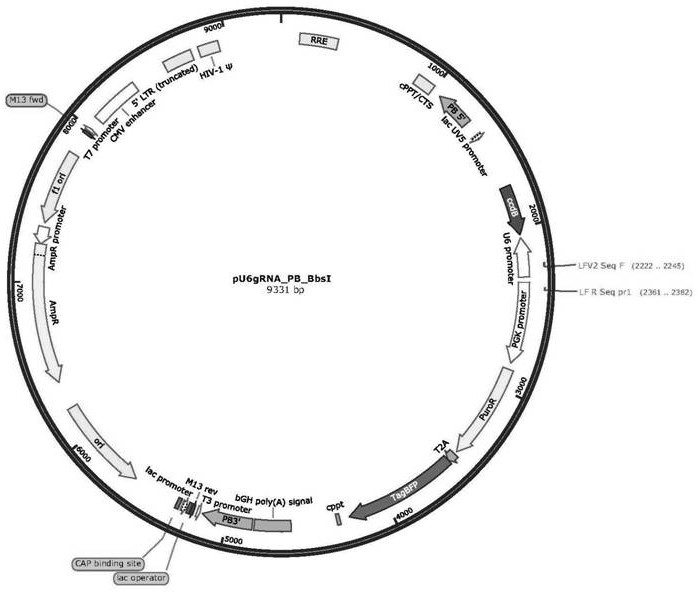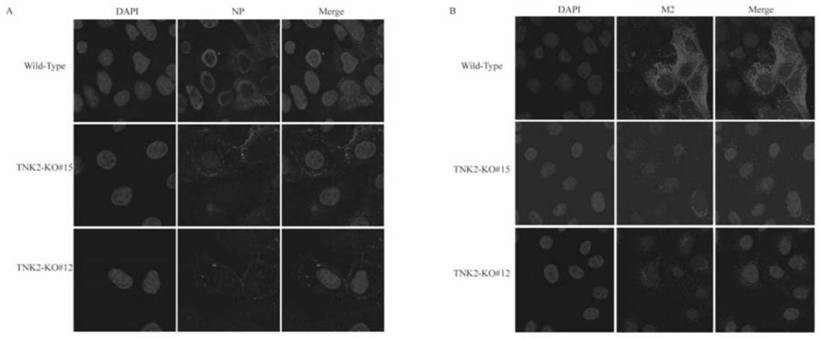Application of non-receptor tyrosine kinase TNK2 protein in prevention and treatment of influenza virus infection
A tyrosine kinase, anti-influenza virus technology, applied in the field of biomedicine, can solve the problem that the vaccine effect cannot reach the ideal state, and achieve good application value, broad-spectrum antiviral effect, and replication inhibition effect.
- Summary
- Abstract
- Description
- Claims
- Application Information
AI Technical Summary
Problems solved by technology
Method used
Image
Examples
Embodiment 1
[0028] Example 1 Construction and detection of double gRNA plasmid vector required for human TNK2 gene knockout
[0029] (1) Construction of human TNK2 gene double gRNA plasmid vector
[0030] Obtain the gene sequence of human TNK2 (ENSG00000061938) from the Ensembl database, then design specific upstream and downstream knockout sites for knocking out the first exon of TNK2, and obtain the two best target sequences TNK2- sgRNA1 (targeting sequence: TGGCAGGAATAGGGGACGT) and TNK2-sgRNA2 (targeting sequence: CTCATCATTCTGACTACCG). According to the BbsI restriction endonuclease, design restriction endonuclease sites at both ends of the sgRNA, add CACCG to the 5' end of the gRNA, add GT to the 3' end; add TAAAAC to the 5' end of the reverse complementary sequence, and design 2 pairs sgRNA oligonucleotide chain, the corresponding sequence is as follows: TNK2-sgRNA1 Oligo1: 5'- CACCGTGGCAGGAATAGGGGACGTGT-3'; TNK2-sgRNA1 Oligo2: 5'-TAAAAC ACGTCCCCTATTCCTGCCAC-3'; TNK2-sgRNA2 Oligo1: 5...
example 2
[0033] Example 2 Detection of TNK2 protein expression in monoclonal A549 cells obtained after transfection of TNK2 double gRNA
[0034]The monoclonal cell line screened in Example 1 was inoculated into a 6-well plate for expanded culture, and the Cas9-A549 cells before transfection were used as a control. After the cells were congested, the cells were collected and placed on ice, and an appropriate amount of SDS-PAGE was added. The sample buffer was fully stirred and lysed, placed in a metal bath for 10 minutes to denature, and after centrifugation, the supernatant was taken for SDS-PAGE. After electrophoresis, transfer to PVDF membrane by wet transfer method, use 5% skimmed milk powder to block after transfer, and then incubate rabbit anti-human TNK2 antibody (1:1000, Abcam), goat anti-rabbit IgG (IgG-HRP) as the secondary antibody, Antigen-antibody complex detection was performed to verify the protein expression level of the TNK2 gene knockout A549 monoclonal cell line. Exp...
example 3
[0035] Influence on Influenza Virus Infection after Example 3 TNK2 Knockout
[0036] Using monoclonal cell lines with stable knockout of TNK2, they were infected with human, porcine and avian influenza viruses respectively. Immunofluorescence and virus titer detection techniques were used to detect the effect of inhibiting or hindering the expression of TNK2 on influenza virus infection.
[0037] The specific method of immunofluorescence is as follows: After the TNK2-knockout monoclonal cell line and wild-type cells were infected with influenza virus for a corresponding period of time, the supernatant was aspirated and washed twice with PBS; the cells were fixed with 4% paraformaldehyde for 10 minutes Afterwards, discard the fixative, wash with PBS 3 times; add 0.2% Triton-X 100 and place at room temperature for 5 minutes to increase the permeability of the cell membrane; discard Triton-X 100, wash 3 times with 1×PBS; add Han 10 %BSA in PBS, place on a horizontal shaker to blo...
PUM
 Login to View More
Login to View More Abstract
Description
Claims
Application Information
 Login to View More
Login to View More - R&D
- Intellectual Property
- Life Sciences
- Materials
- Tech Scout
- Unparalleled Data Quality
- Higher Quality Content
- 60% Fewer Hallucinations
Browse by: Latest US Patents, China's latest patents, Technical Efficacy Thesaurus, Application Domain, Technology Topic, Popular Technical Reports.
© 2025 PatSnap. All rights reserved.Legal|Privacy policy|Modern Slavery Act Transparency Statement|Sitemap|About US| Contact US: help@patsnap.com



